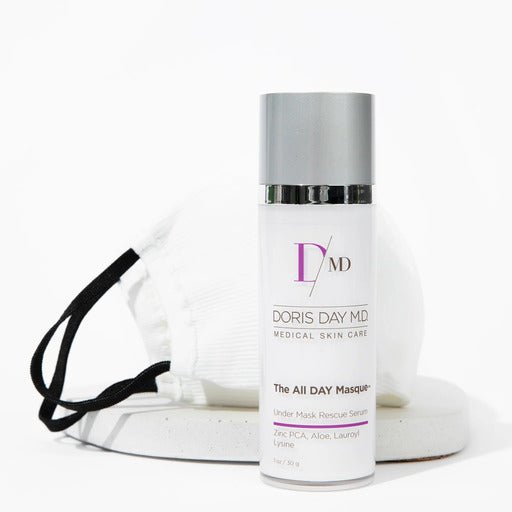With many still unvaccinated and with the rise of the Delta and other variants, masks are going to be a mainstay in our protection against COVID. But wearing a mask does not mean sacrificing beautiful healthy skin. Maskne is a rash that comes from a combination of friction of the mask against the skin, moisture imbalance from air trapped behind the mask and the germs that are then able to colonize and wreak havoc on your skin. In my blog, I help explain what happens and how to protect your skin, beautifully.

Maskne Redux: Masks, and Maskne are Still a Thing
For a minute it seemed like the miracle of the vaccine would free us from the daily mask requirements but with the rise of the Delta variant and with enough people still not yet vaccinated, it seems masks are still going to be a part of our daily routine for a while to come. I have been seeing more and more people with recurring maskne and here’s what I’ve learned.
Skin Dysfunction
Let’s start at the top, with the mask itself. The material of the mask, along with its fit, has an impact on both its level of protection and its effect on your skin. Earlier masks were often made out of repurposed fabrics not designed or tested on delicate facial skin, offering less than ideal protection against COVID-19. Not to mention, many made it difficult to breathe. The microenvironment beneath the mask is starkly different from normal skin at its baseline. There is increased humidity from your breath and increased circulating microbes. On top of that, the constant act of removing and reapplying the mask throughout the day has your skin cycling through environmental extremes.
This persistent loop of wet/dry states results in a condition that I call dyshidrosis, which ultimately leads to breakdown of the delicate facial skin as well as the breakouts we have all come to know as “maskne”.
Other factors include:
- Hormones: It is common for women in their 20’s to begin experiencing hormonal acne. These pesky breakouts typically show up right where you want them least...around the mouth and along the jawline. It can be exacerbated by going on or off hormonal contraceptives
- Products: Using products that are either too rich or too irritating to this delicate area of the face can increase breakouts, especially while wearing a mask
- Cleansing: Incomplete removal of makeup day after day or over exfoliating can lead to a rash that includes redness and whiteheads
- Friction: Just the friction from masks can cause irritation and breakouts
Solutions:
What to wear?
My favorite is my DMD face mask. It is a first-of-its-kind reusable face mask where each fiber is infused with copper and shea butter, using patented technology, to help prevent “maskne” while simultaneously moisturizing dried out skin and protecting the microbiome of the skin. The copper is a natural antibacterial and the shea butter may even improve the appearance of fine lines and wrinkles by keeping the skin hydrated. This means the fabric is locking in moisture while also acting as a facial decontaminant. The mask is designed for comfort and breathability, made with softer ear loops. Plus, it is machine washable and the effects last through up to at least 60 wash cycles.

Skin Care Options
The next crucial component is what you put on the skin itself. It is important to minimize dyshidrosis (aka water imbalance in the skin), improve the skin’s own protective barrier, and allow for repair. These lesions are best treated with gentle exfoliation and retinoids.
- Proper cleansing: Use a gentle cleanser and completely remove all makeup each day.
- The All DAY Masque is my ground-breaking patent-pending serum that creates an invisible nourishing cushion to help rescue skin from “maskne” and other challenges related to wearing a mask. Key ingredients include a powerful cocktail of natural lipids along with soothing aloe vera, lauroyl lysine and zinc PCA to help protect and restore your skin’s natural microbiome. It also contains and peptides as well as allantoin to gently exfoliate and remove dead skin cells.
- Do not over-exfoliate. This can over strip the outer layers of the skin, leading to increased water loss and increased skin sensitivity.
- Consider using lower concentrations of retinol, glycolic and salicylic acid. These chemical exfoliants can make the skin extra-sensitive.
- Hydrate properly. Look for ingredients like hyaluronic acid and ceramides. These are natural and familiar compounds for the skin and can help maintain water balance and skin health.
- Use soothing and antiseptic ingredients. I like aloe, allantoin and zinc.
Bottom Line
Masks are here to stay, learn how to wear them effectively to minimize rashes and breakouts. There are effective ways to minimize and manage maskne, including avoiding irritants, wearing a proper fitting mask with material designed for the face and using the right product to treat reactions as they happen.




![[The Science ] of Longevity: A Skin Focused Approach](http://dorisdaymd.com/cdn/shop/articles/Longevity3-9658695.jpg?v=1765451344)
![[Q&A Session] How Can I Regain Lost Collagen?](http://dorisdaymd.com/cdn/shop/articles/blog_collagen-129369-9354398_e967da1d-cb0e-4086-8c0d-714e0114968f-6680265.jpg?v=1763048229)
